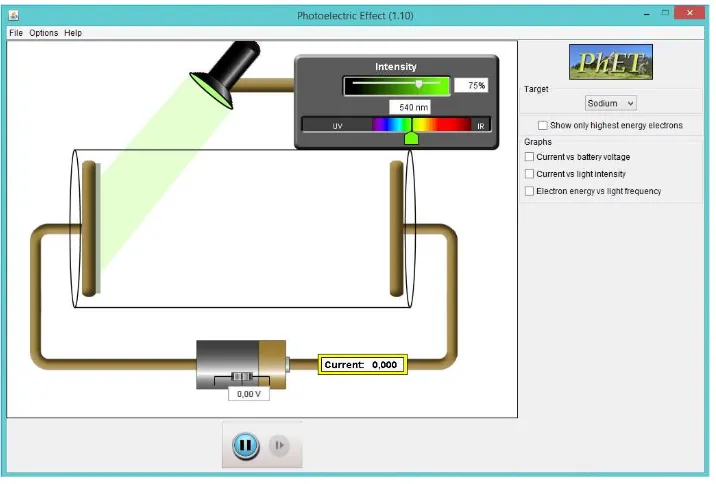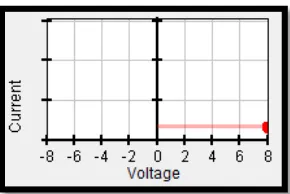4th ICRIEMS Proceedings
Satriya Ary Hapsara
b), Debora Natalia Sudjito
a), Diane Noviandini
Department of Physics Education, Faculty of Science and Mathematics, Universitas Kristen Satya Wacana
Jl. Diponegoro 52-60, Salatiga 50711, Jawa Tengah, Indonesia
a)Corresponding author: debora.natalia@staff.uksw.edu b)642011005@student.uksw.edu
Abstract. Photoelectric effect is one of the fundamental phenomena of quantum mechanics for understanding the nature of light. The science education experts proposed a huge advantages of laboratory experiments activities, especially its potency for unserstanding the photoelectric effect. The availability of photoelectric experimental equipment in the real laboratory is very limited. It influences students’ conception about photoelectric effect. Therefore, Physics Education Technology (PhET) can be used as virtual laboratory for doing photoelectric effect experiment, mainly about the factors affecting the number of threshold wavelength. The purpose of this research is to study the factors influencing the number of threshold wavelength. The light intensity, the voltage, and the metal material used as the research variables are available in PhET simulation of photoelectric effect. By using PhET simulation, there are three experiments that can be done, namely: the effect of the light intensity to the threshold wavelength, the effect of the voltage to the threshold wavelength, and the effect of the metal material to the threshold wavelength. According to PhET simulation, only the metal material influenced the threshold wavelength and this is consistent to references. Thus, the investigation of factors influencing the threshold wavelength can be done using photoelectric effect simulation on virtual laboratory PhET.
INTRODUCTION
The science education experts said that there were a lot of benefits from laboratory experiments, especially about the potency of understandingthe photoelectric effect phenomena from it [1,3]. A photoelectric effect is a phenomenon of quantum mechanics that explains the nature of light as a photon. The limitation of traditional real laboratory in photoelectric effect apparatus is that it is not able to significantly build students’ concept of the photoelectric effect. Computer simulations and animations can be used as an alternative for doing modern physics experiment activities, including the photoelectric effect. Research studies have also indicated that visualization of this phenomenon through computer simulations can contribute to develop students’ understanding of physics concepts at the molecular level by attaching mental images to these concepts.
P-10
EXPERIMENT
This study is a qualitative research that describes the exploration of the photoelectric effect simulation on PhET virtual laboratory (Physics Education Technology) in order to investigate factors that influence the number of threshold wavelength in the photoelectric effect. Some experiments that have been done in order to comprehend the factors that influence the number of threshold wavelength in photoelectric effect were explored in this study.
There were four activities which had been done, i.e. : (1) investigating the effect of light intensity to threshold wavelength, (2) investigating the effect of voltage to threshold wavelength, and (3) investigating the effect of metal material to threshold wavelength. On each activity, all variables would be determined to guide how to find factors that influence the number of threshold wavelength in the photoelectric effect. The results in each activity would be compared to the references to ensure the consistency among the experiments results using virtual laboratoryPhET towards the prevailing theory.
RESULTS AND DISCUSSION
To investigate factors that influence the number of threshold wavelength in the photoelectric effect, some variables such as light intensity, voltage, and metal material could be examined using the photoelectric effect simulation on PhET virtual laboratory. In this case, a number of light wavelengths when the electrons cannot be emitted from the material are used as the indicator of the threshold wavelength.
FIGURE 1. PhET simulation is used to investigate factors that influence the number of the threshold wavelength in the photoelectric effect.
Activity 1. The Effect of Voltage Towards the Number of Threshold Wavelength.
According to the previous study [5] about the effect of voltage towards the number of emitted electrons using
P-11
FIGURE 2. The emitted electrons (current) towards voltage graphat λ=180 nm, metal material = Sodium, I=75% and V = 0-8V.
Thus, voltage does not affect the number of threshold wavelength in photoelectric effect because emitted electrons are not affected by voltage as shown in Table 1.
TABLE 2. The experiment results of the effect of voltage towards the number of threshold wavelength.
Metal Material
Activity 2. The Effect of Metal Material Towards the Number of Threshold Wavelength.
To investigate the effect of the metal material towards the number of threshold wavelength, the metal material was determined as the dependent variable; the threshold wavelength was determined as the independent variable; the voltage and the light intensity were determined as the controlled variables.One by one, the metal material was changed to Sodium, Zinc, Copper, Platinum, and Calsium. The chosen light intensity (I) was 100% to measure the threshold wavelength produces on each metal material changes. The measurement results of electrical current (i) were recorded on Table 1.
TABLE 1. The experiment results of the effect of metal material towards the number of threshold wavelength.
Metal Materials
Activity 3. The Effect of Light Intensity Towards the Number of Threshold Wavelength.
To investigate the effect of light intensity towards the number of threshold wavelength, the light intensity was determined as the dependent variable; the threshold wavelength was determined as the independent variable; the voltage and the metal material were determined as the controlled variables.
P-12
TABLE 2. The experiment results of the effect of light intensity towards the number of threshold wavelength.
Metal Material affected by the light intensity. It is because the minimum energy required to release electrons from the material surface (the photoelectric) work function is constant in its magnitude and it is not affected by the light intensity, but by the metal materials. Light intensity affects the number of emitted electron and it does not affect the photoelectric work function.
Based on the exploration of PhET simulation by doing three activities as mentioned above, the result shows that the threshold wavelength in the photoelectric effect is affected only by the metal materials. It is consistent to the references[4]. Therefore, the photoelectric effect simulation on PhET can be used in the learning process to investigate factors that influence the number of threshold wavelength in the photoelectric effect.
CONCLUSION
The exploration of the photoelectric effect simulation on PhET shows that factors influencing the threshold wavelength in the photoelectric effect is only the metal material as mentioned in the prevailing theory. Thus, the photoelectric effect simulation on PhET can be used in physics learning to investigate factors that influence the threshold wavelength in the photoelectric effect.
REFERENCES
1. M. Bajpai andA. Kumar,Effect of Virtual Laboratory on Students’ Conceptual Achievement in Physics,
International Journal of Current Research, 7, No.2,12808-12813, (2015).
2. S. S. Romualdo Jr., Modern Physics for High School Students, Global Journal of Science Frontier Research E – Interdiciplinary, 15, No. 1, (2015).
3. M. Bajpai, Effectiveness of Developing Concepts in Photoelectric Effect Through Virtual Lab Experiment,
International Journal of Engineering and Advanced Technology (IJEAT),1, No. 6, (2012).
4. A. Beiser. 2003. Concept of Modern Physics, Sixth Edition, (McGraw-Hill International Book Company, New York, 2003) p. 22-66.


